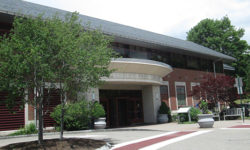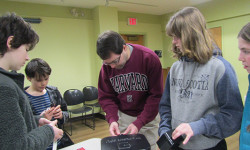[ccfic caption-text format="plaintext"]
By James Kinneen
Hometown Weekly Reporter
Most people assume that every piece of origami was invented hundreds of years ago in Japan. This is incorrect, as origami is a legitimate art with new pieces being created every day. To this end, on Sunday afternoon, September 29, the Wellesley Library hosted origami masters Michael G. LaFosse and Richard L. Alexander from Origamido Studio. The masters taught two classes, which included the creation of pieces they’ve invented.
The first class was for beginners, and saw the crowd make a sailboat, a penguin, and an owl bookmark that LaFosse created for the launch party of one of the “Harry Potter” novels. To teach the beginners, LaFosse uses a technique called “Storigami”, wherein rather than just telling people to fold the paper a certain way, he creates a fun story so that people will remember it. So, while he could have just said “fold this edge here,” LaFosse would tell a story about a hiker that climbs up a mountain then skis down it before an earthquake happens.
Alexander spoke of storigami’s ability to act as a great memory tool. “A parable,” he explained, “is the best way to teach any type of concept. We use very silly visual images with storigami because we find that the sillier the image, the easier for people to remember. It’s important to link one thing to another, but storigami is an incredibly powerful way to remember something.”
When the beginner’s class ended, LaFosse taught the advanced class, which saw audience members create a bat with which Lafosse and Alexander had once populated the windows of Sak’s Fifth Avenue for a Halloween fashion display. Outside of the level of skill needed, Alexander noted that the artistry of the advanced class was different because of the techniques used.
“The advanced class will require more of an artful treatment that involves shaping the paper, whereas in the beginner class it’s a series of flat, straight folds - that goes here, that goes there. There’s no wet-folding or more advanced techniques.”
Wet-folding is a technique wherein a folder lightly wets the paper, then quickly folds it before it dries. Other advanced techniques in the advanced class included the use of a skewer to both curl the paper and create the bat’s mouth by pulling apart just a small bit of the paper. Everyone in the advanced class also got a free copy of LaFosse’s book, “Paper Animals,” to create other origami animals or the bat, should they not recall the steps.
Both LaFosse and Alexander spoke about how international origami has become, with LaFosse talking about how he used to send people origami animals for other folders to reverse-engineer, and Alexander speaking on the influence Japan’s Akira Yoshizawa (whom the two befriended in his later years) had on the art.
Still, while there are books and tutorials on the internet, LaFosse pointed out that the most amazing thing about the art is when they do it void of instruction.
“The most amazing thing about origami is how it empowers a young folder, or even a beginner,” he said. “When they realize that with just the information in their mind, the space between their ears, they can turn a piece of paper into any kind of creature or airplane, box toy or flower. It’s just amazing when they realize they have that power.”
On Sunday, LaFosse and Alexander likely lit that spark for more than a few library attendees.























